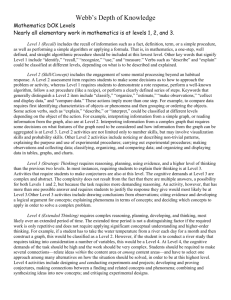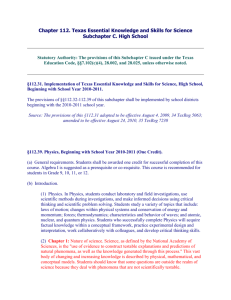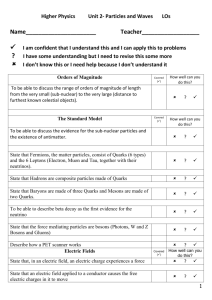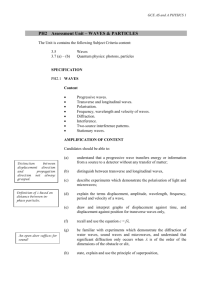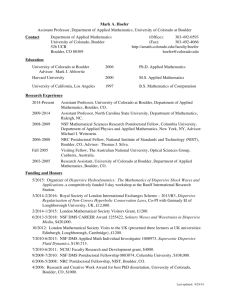Big Idea 1 - Cloudfront.net
advertisement
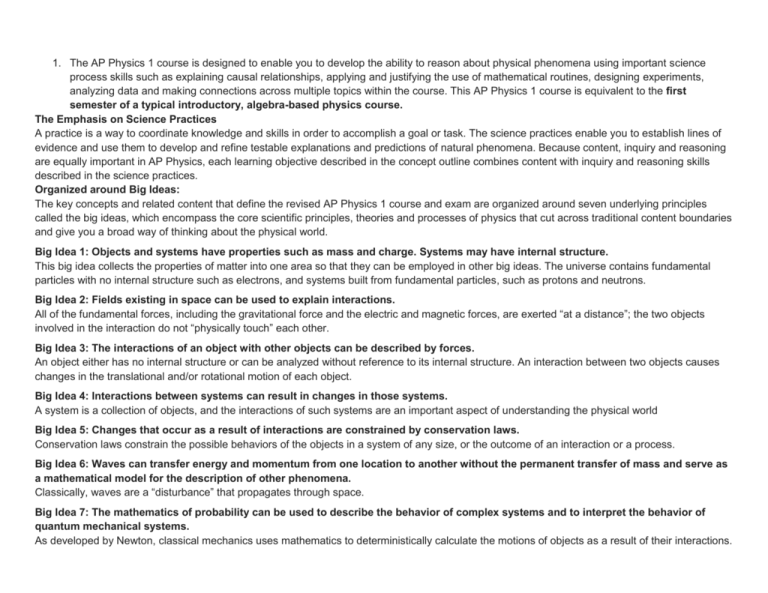
1. The AP Physics 1 course is designed to enable you to develop the ability to reason about physical phenomena using important science process skills such as explaining causal relationships, applying and justifying the use of mathematical routines, designing experiments, analyzing data and making connections across multiple topics within the course. This AP Physics 1 course is equivalent to the first semester of a typical introductory, algebra-based physics course. The Emphasis on Science Practices A practice is a way to coordinate knowledge and skills in order to accomplish a goal or task. The science practices enable you to establish lines of evidence and use them to develop and refine testable explanations and predictions of natural phenomena. Because content, inquiry and reasoning are equally important in AP Physics, each learning objective described in the concept outline combines content with inquiry and reasoning skills described in the science practices. Organized around Big Ideas: The key concepts and related content that define the revised AP Physics 1 course and exam are organized around seven underlying principles called the big ideas, which encompass the core scientific principles, theories and processes of physics that cut across traditional content boundaries and give you a broad way of thinking about the physical world. Big Idea 1: Objects and systems have properties such as mass and charge. Systems may have internal structure. This big idea collects the properties of matter into one area so that they can be employed in other big ideas. The universe contains fundamental particles with no internal structure such as electrons, and systems built from fundamental particles, such as protons and neutrons. Big Idea 2: Fields existing in space can be used to explain interactions. All of the fundamental forces, including the gravitational force and the electric and magnetic forces, are exerted “at a distance”; the two objects involved in the interaction do not “physically touch” each other. Big Idea 3: The interactions of an object with other objects can be described by forces. An object either has no internal structure or can be analyzed without reference to its internal structure. An interaction between two objects causes changes in the translational and/or rotational motion of each object. Big Idea 4: Interactions between systems can result in changes in those systems. A system is a collection of objects, and the interactions of such systems are an important aspect of understanding the physical world Big Idea 5: Changes that occur as a result of interactions are constrained by conservation laws. Conservation laws constrain the possible behaviors of the objects in a system of any size, or the outcome of an interaction or a process. Big Idea 6: Waves can transfer energy and momentum from one location to another without the permanent transfer of mass and serve as a mathematical model for the description of other phenomena. Classically, waves are a “disturbance” that propagates through space. Big Idea 7: The mathematics of probability can be used to describe the behavior of complex systems and to interpret the behavior of quantum mechanical systems. As developed by Newton, classical mechanics uses mathematics to deterministically calculate the motions of objects as a result of their interactions. Big Idea 1: Objects and systems have properties such as mass and charge. Systems may have internal structure. This big idea collects the properties of matter into one area so that they can be employed in other big ideas. The universe contains fundamental particles with no internal structure such as electrons, and systems built from fundamental particles, such as protons and neutrons. Big Idea 2: Fields existing in space can be used to explain interactions. All of the fundamental forces, including the gravitational force and the electric and magnetic forces, are exerted “at a distance”; the two objects involved in the interaction do not “physically touch” each other. Big Idea 3: The interactions of an object with other objects can be described by forces. An object either has no internal structure or can be analyzed without reference to its internal structure. An interaction between two objects causes changes in the translational and/or rotational motion of each object. Big Idea 4: Interactions between systems can result in changes in those systems. A system is a collection of objects, and the interactions of such systems are an important aspect of understanding the physical world. Big Idea 5: Changes that occur as a result of interactions are constrained by conservation laws. Conservation laws constrain the possible behaviors of the objects in a system of any size, or the outcome of an interaction or a process. Big Idea 6: Waves can transfer energy and momentum from one location to another without the permanent transfer of mass and serve as a mathematical model for the description of other phenomena. Classically, waves are a “disturbance” that propagates through space. Big Idea 7: The mathematics of probability can be used to describe the behavior of complex systems and to interpret the behavior of quantum mechanical systems. As developed by Newton, classical mechanics uses mathematics to deterministically calculate the motions of objects as a result of their interactions.

